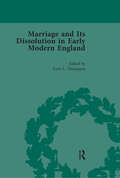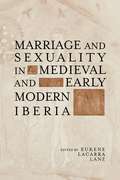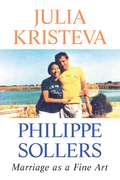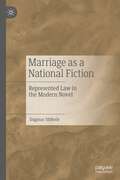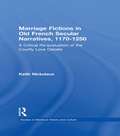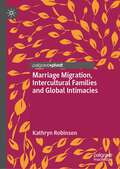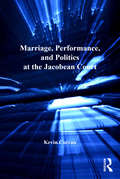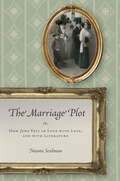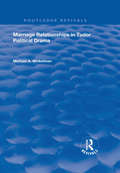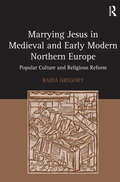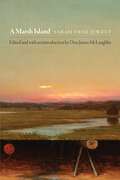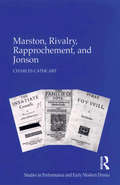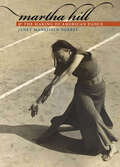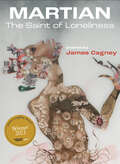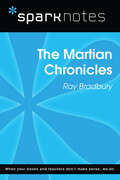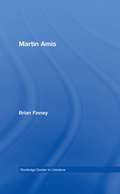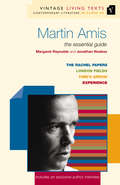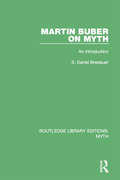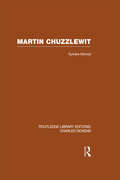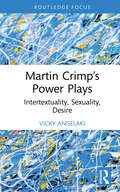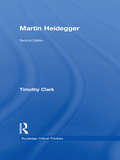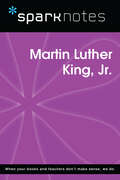- Table View
- List View
Marriage and Its Dissolution in Early Modern England, Volume 4
by Torri L ThompsonAddresses Early Modern representations of chastity and adultery, as well as matrimony and its dissolution in both the private and public realms, including the most well known marital dissolution, that of Henry VIII and Catherine of Aragon.
Marriage and Sexuality in Medieval and Early Modern Iberia (Hispanic Issues #26)
by Eukene Lacarra LanzFirst published in 2002. Routledge is an imprint of Taylor & Francis, an informa company.
Marriage as a Fine Art
by Julia Kristeva Philippe Sollers"We found so much to say, to share, to learn.... For it wasn't just the Marquis de Sade profile and the sporty thighs-and-calves that seduced me. It was even more, perhaps, or certainly just as much, the speed at which you used to read, and still do."—Julia Kristeva"We're married, Julia and I, that's a fact, but we each have our own personalities, our own name, activities, and freedom. Love is the full recognition of the other in their otherness. If this other is very close to you, as in this case, it seems to me that what's at stake is harmony within difference. The difference between men and women is irreducible; there's no possibility of fusion."—Philippe SollersMarriage as a Fine Art is an enchanting series of exchanges in which Julia Kristeva and Philippe Sollers, married for fifty years, speak candidly about their love. Though they live separately, Kristeva and Sollers are fully committed to each other. Their bond is intellectual and psychological, passionate and mundane. They share everything when together, and lose themselves in their interests when apart. Their marriage is art, rich with history and meaning, idiosyncratic, and dynamic in its expression. Yet it is also as common as they come. Kristeva and Sollers have lived through the same challenges, peaks, and lulls as all married couples do. With humor and honesty, they elaborate on these moments, turning marriage's familiar aspects into exceptional examples of relating, struggling, transcending, and being. Marriage as a Fine Art is a rare chance to know these intellectuals—and marriage—more intimately.
Marriage as a National Fiction: Represented Law in the Modern Novel
by Dagmar StöferleThere is a prehistory of the adultery novel, which became a pan-European literary paradigm in the second half of the 19th century. In the wake of the French Revolution, secular marriage legislation emerges, producing a metaphorical surplus that is still effective today. Using legal history and canonical literary texts from Rousseau to Goethe and Manzoni to Hugo and Flaubert, this book traces how marriage around 1800 became a figure of reflection for the modern nation-state. In the process, original contributions to the philology of the individual texts emerge. At the same time, law and literature are made fruitful for a historical semantics of society and community.This book is a translation of an original German 1st edition “Ehe als Nationalfiktion” by Dagmar Stöferle, published by J.B. Metzler, imprint of Springer-Verlag GmbH Germany, part of Springer Nature in 2020. The translation was done with the help of artificial intelligence (machine translation by the service DeepL.com). The author (with the support of Chris Owain Carter) has subsequently revised the text further in an endeavour to refine the work stylistically.
Marriage Fictions in Old French Secular Narratives, 1170-1250: A Critical Re-evaluation of the Courtly Love Debate (Studies in Medieval History and Culture)
by Keith NickolausNickolaus provides the readers with a concise critical discussion of the "courtly love" debate, broad historical and comparative analysis, and a model that explains, at the level of plot, rhetoric, and ideology, the proper place of amorous motifs in the context of prevailing Christian doctrines and attitudes.
Marriage Migration, Intercultural Families and Global Intimacies
by Kathryn RobinsonThis book brings an innovative study of marriage migration in Australia, offering new insights into issues of intimacy and authenticity online. In doing so, it delivers on five main objectives: exploring emotional attachment and personal life in global spaces; interrogating stereotypes and their pervasive influence on personal relations; analysing attitudes and social practice within the institution of marriage; investigating immigration policy, marriage, and citizens’ rights; theorizing gender and class relations in the current global order. The analysis moves between ‘online’ and ‘offline’ social relations and processes, with comparative data enabling a critical framing of the data on marriage relationships developed online. This important contribution places contemporary forms of transcultural marriage and marriage brokering in a historical context of ‘marriage’ in the ‘Anglosphere’ tradition, and in particular historical forms of marriage migration in settler colonial and now multicultural Australia—including histories of colonial era ‘bride ships’ and post WW2 ‘proxy brides’ from southern Europe.
Marriage, Performance, and Politics at the Jacobean Court (Studies In Performance And Early Modern Drama Ser.)
by Kevin CurranMarriage, Performance, and Politics at the Jacobean Court constitutes the first full-length study of Jacobean nuptial performance, a hitherto unexplored branch of early modern theater consisting of masques and entertainments performed for high-profile weddings. Scripted by such writers as Ben Jonson, Thomas Campion, George Chapman, and Francis Beaumont, these entertainments were mounted for some of the most significant political events of James's English reign. Here Kevin Curran analyzes all six of the elite weddings celebrated at the Jacobean court, reading the masques and entertainments that headlined these events alongside contemporaneously produced panegyrics, festival books, sermons, parliamentary speeches, and other sources. The study shows how, collectively, wedding entertainments turned the idea of union into a politically versatile category of national representation and offered new ways of imagining a specifically Jacobean form of national identity by doing so.
The Marriage Plot: Or, How Jews Fell in Love with Love, and with Literature
by Naomi SeidmanFor nineteenth-century Eastern European Jews, modernization entailed the abandonment of arranged marriage in favor of the "love match." Romantic novels taught Jewish readers the rules of romance and the choreography of courtship. But because these new conceptions of romance were rooted in the Christian and chivalric traditions, the Jewish embrace of "the love religion" was always partial. In The Marriage Plot, Naomi Seidman considers the evolution of Jewish love and marriage though the literature that provided Jews with a sentimental education, highlighting a persistent ambivalence in the Jewish adoption of European romantic ideologies. Nineteenth-century Hebrew and Yiddish literature tempered romantic love with the claims of family and community, and treated the rules of gender complementarity as comedic fodder. Twentieth-century Jewish writers turned back to tradition, finding pleasures in matchmaking, intergenerational ties, and sexual segregation. In the modern Jewish voices of Sigmund Freud, Erica Jong, Philip Roth, and Tony Kushner, the Jewish heretical challenge to the European romantic sublime has become the central sexual ideology of our time.
Marriage Relationships in Tudor Political Drama (Routledge Revivals)
by Michael A. WinkelmanOriginally published in 2005. While several recent studies have investigated the political dimensions of sixteenth-century English drama, until now there has not been a monograph that tells the story of how and why royal marital selection was examined. By linking court interludes, neoclassical university tragedies, and popular plays by late Elizabethan dramatists Christopher Marlowe, John Lyly, Thomas Kyd, and William Shakespeare to the inflammatory topic of Tudor marriage, Michael Winkelman demonstrates their cultural centrality. This new work interrogates the symbolic, allusive, and mimetic aspects of marital relationships in such plays. Winkelman argues that they were crucial battlegrounds for a series of consequential debates about the future of the monarchy, especially during the reigns of the oft-married King Henry VIII and his unmarried daughter, the Virgin Queen Elizabeth I. Marriage, as a critically important political metaphor as well as a pressing realpolitik quandary, was the subject of major debate in the drama and government of Tudor England. Royal conduct in the domestic sphere had a tremendous impact on the entire English social order, and in an age before widespread freedom of speech, court drama was often the only venue where the voicing of criticism was tolerated. The fascinating soap-opera story of Tudor marriage thus provides the author with a reference point for an interdisciplinary study of sixteenth-century theatre and politics. Drawing on evidence from playbooks and historical chronicles as well as contemporary work in gender studies, audience-response theory, and anthropology, this book explores how during a time of anxiety-inducing change, playwrights discussed controversies and propounded remedies; theatre played a pivotal role in shaping society.
Marrying Jesus in Medieval and Early Modern Northern Europe: Popular Culture and Religious Reform
by Rabia GregoryThe first full-length study of the notion of marriage to Jesus in late medieval and early modern popular culture, this book treats the transmission and transformation of ideas about this concept as a case study in the formation of religious belief and popular culture. Marrying Jesus in Medieval and Early Modern Northern Europe provides a history of the dispersion of theology about the bride of Christ in the period between the twelfth and seventeenth centuries and explains how this metaphor, initially devised for a religious elite, became integral to the laity's pursuit of salvation. Unlike recent publications on the bride of Christ, which explore the gendering of sanctity or the poetics of religious eroticism, this is a study of popular religion told through devotional media and other technologies of salvation. Marrying Jesus argues against the heteronormative interpretation that brides of Christ should be female by reconstructing the cultural production of brides of Christ in late medieval Europe. A central assertion of this book is that by the fourteenth century, worldly, sexually active brides of Christ, both male and female, were no longer aberrations. Analyzing understudied vernacular sources from the late medieval period - including sermons, early printed books, spiritual diaries, letters, songs, and hagiographies - Rabia Gregory shows how marrying Jesus was central to late medieval lay piety, and how the 'chaste' bride of Christ developed out of sixteenth-century religious disputes.
Marrying Jesus in Medieval and Early Modern Northern Europe: Popular Culture and Religious Reform
by Rabia GregoryThe first full-length study of the notion of marriage to Jesus in late medieval and early modern popular culture, this book treats the transmission and transformation of ideas about this concept as a case study in the formation of religious belief and popular culture. Marrying Jesus in Medieval and Early Modern Northern Europe provides a history of the dispersion of theology about the bride of Christ in the period between the twelfth and seventeenth centuries and explains how this metaphor, initially devised for a religious elite, became integral to the laity's pursuit of salvation. Unlike recent publications on the bride of Christ, which explore the gendering of sanctity or the poetics of religious eroticism, this is a study of popular religion told through devotional media and other technologies of salvation. Marrying Jesus argues against the heteronormative interpretation that brides of Christ should be female by reconstructing the cultural production of brides of Christ in late medieval Europe. A central assertion of this book is that by the fourteenth century, worldly, sexually active brides of Christ, both male and female, were no longer aberrations. Analyzing understudied vernacular sources from the late medieval period - including sermons, early printed books, spiritual diaries, letters, songs, and hagiographies - Rabia Gregory shows how marrying Jesus was central to late medieval lay piety, and how the 'chaste' bride of Christ developed out of sixteenth-century religious disputes.
A Marsh Island (Q19: The Queer American Nineteenth Century)
by Sarah Orne JewettToward the end of her life, Sarah Orne Jewett (1849–1909) made a surprising disclosure. Instead of the critically lauded The Country of the Pointed Firs, Jewett declared her “best story” to be A Marsh Island (1885), a little-known novel. Why? One reason is that it demonstrates Jewett’s range. Known primarily for her vignettes, Jewett accomplished in these pages a truly great novel. Undoubtedly, another reason lies in the novel’s themes of queer kinship and same-sex domesticity, as enjoyed by the flamboyant protagonist Dick Dale. Written a few years into Jewett’s decades-long companionship with Annie Fields, A Marsh Island echoes Jewett’s determination to split time between her family home in Maine and Fields’s place on Charles Street in Boston. The novel follows the adventures of Dale, a Manhattanite landscape painter in the Great Marsh of northeastern Massachusetts and envisions the latter region’s saltmarsh as a figure for dynamic selfhood: the ever-shifting boundaries between land and sea a model for valuing both individuality and a porous openness to the gifts of others.Jewett’s works played a major role in popularizing the genre of American regionalism and have garnered praise, both in her time and ours, for her skill in rendering the local landscapes and fishing villages along or near the coasts of New England. Just as Jewett brought attention to the unique beauty and value of the Great marsh region, editor Don James McLaughlin reveals a convergence of regionalism and sexuality in Jewett’s work in his introduction. A Marsh Island reminds us that queer kinship has a long tradition of being extended to incorporate queer ecological belonging, and that the meaning of “companionship” itself is enriched when we acknowledge its indebtedness to environment.
Marshall McLuhan and Northrop Frye
by B. W. PoweMarshall McLuhan and Northrop Frye are two of Canada's central cultural figures, colleagues and rivals whose careers unfolded in curious harmony even as their intellectual engagement was antagonistic. Poet, novelist, essayist and philosopher B.W. Powe, who studied with both of these formidable and influential intellectuals, presents an exploration of their lives and work in Marshall McLuhan and Northrop Frye: Apocalypse and Alchemy.Powe considers the existence of a unique visionary tradition of Canadian humanism and argues that McLuhan and Frye represent fraught but complementary approaches to the study of literature and to the broader engagement with culture. Examining their eloquent but often acid responses to each other, Powe exposes the scholarly controversies and personal conflicts that erupted between them, and notably the great commonalities in their writing and biographies. Using interviews, letters, notebooks, and their published texts, Powe offers a new alchemy of their thought, in which he combines the philosophical hallmarks of McLuhan's "The medium is the message" and Frye's "the great code."
Marshallese Alphabet (Island Alphabet Books)
by Lori PhillipsThis book is part of the Island Alphabet Books series, which features languages and children's artwork from the U.S.-affiliated Pacific. Each book contains the complete alphabet for the language, four or five examples for each letter, and a word list with English translations.
Marston, Rivalry, Rapprochement, and Jonson (Studies in Performance and Early Modern Drama)
by Charles CathcartSignificant and unexplored signs of John Marston's literary rivalry with Ben Jonson are investigated here by Charles Cathcart. The centrepiece of the book is its argument that the anonymous play The Family of Love, sometimes attributed to Thomas Middleton and sometimes to Lording Barry, was in part the work of John Marston, and that it constitutes a whimsical statement of amity with Jonson. The book concerns itself with material rarely or never viewed as part of the "Poets' War" (such as the mutual attempted cuckoldings of The Insatiate Countess and the Middle Temple performance of Twelfth Night) rather than with texts (like Satiromastix and Poetaster) long considered in this light.
Martha Hill and the Making of American Dance
by Janet Mansfield SoaresA lively and intimate portrait of an unsung heroine in American dance Martha Hill (1900–1995) was one of the most influential figures of twentieth century American dance. Her vision and leadership helped to establish dance as a serious area of study at the university level and solidify its position as a legitimate art form. Setting Hill's story in the context of American postwar culture and women's changing status, this riveting biography shows us how Hill led her colleagues in the development of American contemporary dance from the Kellogg School of Physical Education to Bennington College and the American Dance Festival to the Juilliard School at Lincoln Center. She created pivotal opportunities for Martha Graham, Doris Humphrey, Charles Weidman, Hanya Holm, José Limón, Merce Cunningham, and many others. The book provides an intimate look at the struggles and achievements of a woman dedicated to taking dance out of the college gymnasium and into the theatre, drawing on primary sources that were previously unavailable. It is lavishly illustrated with period photographs.
Martian: The Saint of Loneliness
by James CagneyWinner of the 2021 Academy of American Poets James Laughlin AwardA blistering exploration of America&’s legacy of anti-Black violence from an indispensable poet of our timeAmerican history got you down? Are you feeling alienated? Join poet James Cagney in his blistering second collection, Martian: The Saint of Loneliness, as he journeys through time, space, and memory with caustic, satirical beauty. Recall American history through its spent shell casings! Turn familial ghosts into art valuable for generations! In these fully charged poems, James Cagney storms through American fields blooming with artillery and anger on his thirsty quest for love, peace, and acceptance in the smallest, most precious gestures.
The Martian Chronicles (SparkNotes Literature Guide Series)
by SparkNotesThe Martian Chronicles (SparkNotes Literature Guide) by Ray Bradbury Making the reading experience fun! Created by Harvard students for students everywhere, SparkNotes is a new breed of study guide: smarter, better, faster. Geared to what today's students need to know, SparkNotes provides: *Chapter-by-chapter analysis *Explanations of key themes, motifs, and symbols *A review quiz and essay topicsLively and accessible, these guides are perfect for late-night studying and writing papers
Martin Amis (Routledge Guides to Literature)
by Brian FinneyBooker-shortlisted for Time's Arrow and widely known for his novels, short stories, essays, reviews, and autobiographical works, Martin Amis is one of the most influential of contemporary British writers. This guide to Amis's diverse and often controversial work offers: an accessible introduction to the contexts and many interpretations of his texts, from publication to the present an introduction to key critical texts and perspectives on Amis's life and work, situated within a broader critical history cross-references between sections of the guide, in order to suggest links between texts, contexts and criticism suggestions for further reading. Part of the Routledge Guides to Literature series, this volume is essential reading for all those beginning detailed study of Martin Amis and seeking not only a guide to his works but also a way through the wealth of contextual and critical material that surrounds them.
Martin Amis: The Essential Guide (Vintage Living Texts #9)
by Jonathan Noakes Margaret ReynoldsIn Vintage Living Texts, teachers and students will find the essential guide to the works of Martin Amis. Vintage Living Texts is unique in that it offers an in-depth interview with Martin Amis, relating specifically to the texts under discussion. This guide deals with Amis's themes, genre and narrative technique, and a close reading of the texts will provide a rich source of ideas for intelligent and inventive ways of approaching the novels.
Martin Buber on Myth: An Introduction (Routledge Library Editions: Myth #1)
by S. Daniel BreslauerThis book, first published in 1990, summarizes and evaluates the contribution of Martin Buber as a theorist of myth. Buber provides explicit guidelines for understanding and evaluating myths. He describes reality as twofold: people live either in a world of things, to which they relate as a subject controlling its objects, or in a world of self-conscious others, with whom one relates as fellow subjects. Human beings require both types of reality, but also a means of moving from one to the other. Buber understands myths as one such means by which people pass from I-It reality to I-You meeting. In studying myths, he focuses on the myths in the traditions he knows best, but offers his advice and interpretation of mythology and scholarship about mythology generally.
Martin Chuzzlewit: Routledge Library Editions: Charles Dickens Volume 10 (Routledge Library Editions: Charles Dickens #Vol. 10)
by Sylvere MonodAlthough enjoyed my many as a masterpiece of Dickens’ comic writing, Martin Chuzzlewit has long been underrated by professional critics. This volume redresses the balance by devoting its attention to a full critical discussion of the novel and by including a full survey of the critical positions held in the past. As well as discussing the themes of selfishness and hypocrisy, the history of the text is also explored, as is the complex relationship between Dickens and the United States which played a great part in the development of the novel and exerted considerable influence on it early reception.
Martin Crimp’s Power Plays: Intertextuality, Sexuality, Desire (Routledge Advances in Theatre & Performance Studies)
by Vicky AngelakiThis book covers playwright Martin Crimp’s recent work showing how it captures the nuances in our interpersonal contemporary experience. Examining the bold and exciting body of writing by Crimp, the book delves into his depiction of intersections between narratives, as well as between private and public, through an honest look at power structures and shifts, marriages and relationships, sexuality, and desire. This book will be of great interest to students and scholars in Drama, Theatre and Performance, English Literature, and Opera Studies.
Martin Heidegger (Routledge Critical Thinkers)
by Timothy ClarkSince the publication of his mammoth work, Being and Time, Martin Heidegger has remained one of the most influential figures in contemporary thought, and is a key influence for modern literary and cultural theory. This guidebook provides an ideal entry-point for readers new to Heidegger, outlining such issues and concepts as: the limits of 'theory'the history of beingthe origin of the work of artlanguagethe literary workpoetry and the politicalHeidegger's involvement with Nazism.Fully updated throughout and featuring a new section on enviromental thought and ecocriticism, this guidebook clearly and concisely introduces Heidegger's crucial work relating to art, language and poetry, and outlines his continuing influence on critical theory.
Martin Luther King Jr. (SparkNotes Biography Guide)
by SparkNotesMartin Luther King Jr. (SparkNotes Biography Guide) Making the reading experience fun! SparkNotes Biography Guides examine the lives of historical luminaries, from Alexander the Great to Virginia Woolf. Each biography guide includes:An examination of the historical context in which the person lived A summary of the person&’s life and achievements A glossary of important terms, people, and events An in-depth look at the key epochs in the person&’s career Study questions and essay topics A review test Suggestions for further reading Whether you&’re a student of history or just a student cramming for a history exam, SparkNotes Biography guides are a reliable, thorough, and readable resource.
